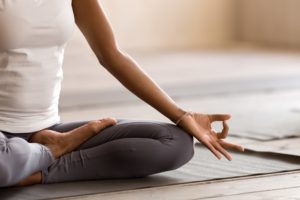Sleeping Upright
Sleeping while sitting upright – or in some cases, standing up – is a common practice throughout the animal kingdom. However, humans often struggle with sleeping upright on occasions when this position is required, such as napping on planes or during long car rides. This can be partly attributed to the way our bodies relax and lose muscle tone during certain stages of a normal sleep cycle.
Moreover, sitting upright for too long can increase your risk of deep vein thrombosis (DVT), a potentially fatal medical condition. If you need to sleep upright, there are certain measures you can take to prevent DVT and ensure an adequate amount of rest.
Are You Getting Enough Deep Sleep?
A variety of issues can cause degrade your sleep quality. Answer three questions to understand if it’s a concern you should worry about.
Is It Healthy to Sleep Sitting Upright?
Sleeping upright is neither inherently healthy nor unhealthy. As long as you’re able to rest comfortably and get enough sleep, the upright position might be the best option. Some people live with medical conditions that make sitting up more comfortable for sleeping. These include morbid obesity and chronic obstructive pulmonary disease.
Some people may also feel more comfortable sleeping in a recliner. “I have had a number of physical therapy patients after various shoulder surgeries tell me that sleeping in a recliner is the only way they can get comfortable,” says Dr. Jenny Iyo, a Doctor of Physical Therapy and member of the SleepFoundation.org medical review panel. “I think this is likely due to the fact that while sleeping in a recliner, it is harder to roll over onto your side, which can cause post-operative shoulder patients a lot of pain.”
However, Dr. Iyo stresses sleeping upright should be a temporary measure until the patient is able to sleep comfortably in bed. She adds patients should consult their physician or physical therapist about the change in posturing before transitioning back to their bed.
The practice of sleeping upright is more common within certain cultural groups. For example, the BBC has profiled a Buddhist retreat in Scotland , during which monks slept upright every night for a period of up to four years.
These groups are the exception, however, as most people tend to have a hard time sleeping upright due to the simple mechanics of our sleep cycles. During the fourth stage, known as rapid eye movement (REM), you’ll experience a loss of muscle tone that causes the arms and legs to feel paralyzed. This temporary paralysis makes sleeping upright less comfortable compared to sleeping prostrate on your side, back, or stomach.
What Is Deep Vein Thrombosis?
The risk of deep vein thrombosis (DVT) is also important to consider, especially during long flights. DVT is characterized by a blood clot that forms in the veins of your thigh or lower leg after long periods of uninterrupted sitting. If the clot travels to the lungs, this can lead to a potentially fatal pulmonary embolism. Taking certain medications can increase your likelihood of developing DVT, as can smoking or being pregnant .
Symptoms of DVT include the following:
- Warmth or feelings of tenderness over the affected vein
- Pain or swelling at the site of the clot
- Reddened skin
To prevent DVT, airline passengers on long flights are often instructed to stand up and stretch their legs periodically while they are in the air. You should also make sure to drink plenty of fluids in order to stay hydrated.
Another way to lower your risk of DVT while sleeping upright during a long trip is to recline your seat if possible. Some studies suggest reclining your seat at an angle of at least 40 degrees leads to healthier sleep than sitting upright at an angle of 20 degrees. Of course, this may not be possible on certain flights, in which case you may need to leave your seat and stretch your legs more frequently.

Can You Sleep Standing Up?
Sleeping while standing is even more difficult for humans than sleeping sitting up due to the loss of muscle tone that occurs during REM sleep. However, this practice has been observed in certain situations, such as soldiers on nighttime sentry duty.
Other animals are more adept at sleeping on their feet. Horses, for instance, are equipped with a system of tendons and ligaments that allow their legs to essentially lock into place while they sleep. Flamingos are another example, and can actually sleep while standing on one leg .
It’s important to note that some sleep disorders can cause people to stand up, and even walk around, without waking up. Sleepwalking is a disorder of arousal. During sleepwalking episodes, a person may get up and walk or run away from their bed. This behavior may occur in people who experience sleep terrors, another disorder of arousal. However, this should not be seen as normal or healthy sleep since it is disorder-related.

Still have questions? Ask our community!
Join our Sleep Care Community — a trusted hub of sleep health professionals, product specialists, and people just like you. Whether you need expert sleep advice for your insomnia or you’re searching for the perfect mattress, we’ve got you covered. Get personalized guidance from the experts who know sleep best.
References
6 Sources
-
Why do Buddhist monks sleep upright? (2009, June 22). BBC News Magazine., Retrieved December 15, 2020, from
http://news.bbc.co.uk/2/hi/uk_news/magazine/8112619.stm -
U.S. National Library of Medicine. (2018, August 10). Deep Vein Thrombosis. MedlinePlus., Retrieved December 15, 2020, from
https://medlineplus.gov/deepveinthrombosis.html -
American Academy of Orthopaedic Surgeons. (2015, June). Deep Vein Thrombosis. OrthoInfo., Retrieved December 15, 2020, from
https://orthoinfo.aaos.org/en/diseases--conditions/deep-vein-thrombosis -
Roach, G. D., Matthews, R., Naweed, A., Kontou, T. G., & Sargent, C. (2018). Flat-out napping: The quantity and quality of sleep obtained in a seat during the daytime increase as the angle of recline of the seat increases. Chronobiology international, 35(6), 872–883.
https://www.tandfonline.com/doi/full/10.1080/07420528.2018.1466801 -
Why Do Horses Sleep Standing Up? Tikkanen, A. Britannica.
https://www.britannica.com/story/why-do-horses-sleep-standing-up -
Andrews, T. M. (2017, May 24). Mystery solved: How flamingos can sleep while standing one one leg. The Washington Post.
https://www.washingtonpost.com/news/morning-mix/wp/2017/05/24/mystery-solved-how-flamingos-can-sleep-while-standing-on-one-leg/


















































